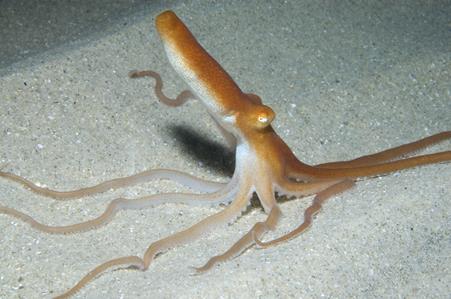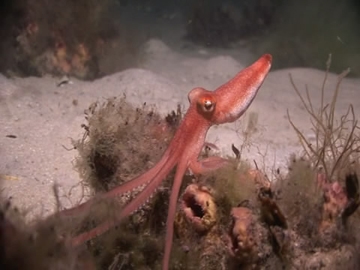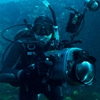General Description
Moderate-sized, elongate octopus. Body may be stretched into a long thin cylinder in some postures. Arms long and narrow reaching fine points. Colour generally pale orange to maroon red. Foraging animals may display a pale base colour with long dark red stripe down each side of the body extending along the side arms. Maximum mantle length to 9 cm, total length to around 42 cm.
Biology
This octopus emerges at night to forage over the sand for small crustaceans by probing its thin arms down burrows and holes. During the day it buries deep in the sand, forming a burrow with a chimney to the surface. It uses mucous and the arm tips to hold back the sand grains to form the chimney. It draws water in from the sand surface by pumping water in and out of its gill cavity, creating the necessary current. If a predator detects the octopus and attacks the sand, the octopus can crawl out of reach of the attacker through the sand. This octopus can bury very quickly by producing its own quicksand. It pumps fast jets of water into the sand making the sand bubble and loosen. It then dives in before the sand resettles. It is possible that females release a sexually attractive chemical as groups of males have been observed swarming over single females. Females lay large eggs that are attached singly to hard surfaces such as shells. The large young hatch and immediately head into the sand. This octopus is locally abundant and is sometimes collected by recreational fishers as bait.
Habitat
Sand substrates in coastal waters to depths of around 50 m.
Soft substrates
Distribution guide
Southern Australia.
Species Group
Octopuses and allies › Octopuses
Depth
Shallow (1-30 m)
Deep ( > 30 m)
Water Column
Max Size
42 cm
Diet
Carnivore
Harmful
Potential to bite, especially if handled. Venom status unknown.
Commercial Species
No
Global Dispersal
Native to Australia
Identify
Conservation Status
- DSE Advisory List : Not listed
- EPBC Act 1999 : Not listed
- IUCN Red List : Not listed








